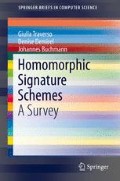Abstract
Together with security, there are many other properties that should be taken into account when evaluating a homomorphic signature scheme. In fact it might be important that a signature generated according to an admissible function is indistinguishable from the original ones. In other scenarios a post-quantum signature scheme is needed. In this case we have to make sure that the underlying hardness assumption is expected to face quantum computer attacks. Furthermore, there are situations where computation efficiency and shortness of the generated signatures are important features. In this chapter we discuss and define formally all the above features.
Access this chapter
Tax calculation will be finalised at checkout
Purchases are for personal use only
References
Abe M, Haralambiev K, Ohkubo M (2010) Signing on elements in bilinear groups for modular protocol design. IACR Cryptology ePrint Archive, 2010:133
Ahn JH, Boneh D, Camenisch J, Hohenberger S, Waters B et al (2012) Computing on authenticated data. In: Theory of cryptography. Springer, Berlin, pp 1–20
Attrapadung N, Libert B (2011) Homomorphic network coding signatures in the standard model. In: Public key cryptography–PKC 2011. Springer, Berlin, pp 17–34
Attrapadung N, Libert B, Peters T (2012) Computing on authenticated data: new privacy definitions and constructions. In: Advances in cryptology–ASIACRYPT 2012. Springer, Berlin, pp 367–385
Attrapadung N, Libert B, Peters T (2013) Efficient completely context-hiding quotable and linearly homomorphic signatures. In: Public-key cryptography–PKC 2013. Springer, Berlin, pp 386–404
Bernstein DJ, Buchmann J, Dahmen E (2009) Post-quantum cryptography. Springer, Berlin
Blake IF, Seroussi G, Smart N (1999) Elliptic curves in cryptography, vol 265. Cambridge University Press, Cambridge
Boneh D, Boyen X (2008) Short signatures without random oracles and the SDH assumption in bilinear groups. J Cryptol 21(2):149–177
Boneh D, Freeman DM (2011) Homomorphic signatures for polynomial functions. In: Advances in cryptology–EUROCRYPT 2011. Springer, Berlin, pp 149–168
Boneh D, Boyen X, Shacham H (2004) Short group signatures. In: Advances in cryptology–CRYPTO 2004. Springer, Berlin, pp 41–55
Boneh D, Freeman D, Katz J, Waters B (2009) Signing a linear subspace: signature schemes for network coding. In: Public key cryptography–PKC 2009. Springer, Berlin, pp 68–87
Catalano D, Fiore D, Warinschi B (2012) Efficient network coding signatures in the standard model. In: Public key cryptography–PKC 2012. Springer, Berlin, pp 680–696
Cramer R, Shoup V (2000) Signature schemes based on the strong RSA assumption. ACM Trans Inf Syst Secur 3(3):161–185
Dutta R, Barua R, Sarkar P (2004) Pairing-based cryptographic protocols: a survey. IACR Cryptology ePrint Archive, 2004:64
Freeman DM (2012) Improved security for linearly homomorphic signatures: a generic framework. In: Public key cryptography–PKC 2012. Springer, Berlin, pp 697–714
Gentry C, Peikert C, Vaikuntanathan V (2008) Trapdoors for hard lattices and new cryptographic constructions. In: Proceedings of the fortieth annual ACM symposium on theory of computing. ACM, New York, pp 197–206
Jing Z (2014) An efficient homomorphic aggregate signature scheme based on lattice. Math Probl Eng
Katz J (2010) Digital signatures. Springer, Berlin
Katz J, Waters B (2008) Compact signatures for network coding
Libert B, Peters T, Joye M, Yung M (2013) Linearly homomorphic structure-preserving signatures and their applications. In: Advances in cryptology–CRYPTO 2013. Springer, Berlin, pp 289–307
Menezes AJ, Okamoto T, Vanstone S et al (1993) Reducing elliptic curve logarithms to logarithms in a finite field. IEEE Trans Inf Theory 39(5):1639–1646
Rivest RL, Shamir A, Adleman L (1978) A method for obtaining digital signatures and public-key cryptosystems. Commun ACM 21(2):120–126
Shor PW (1994) Algorithms for quantum computation: discrete logarithms and factoring. In: 35th annual symposium on foundations of computer science, 1994 proceedings. IEEE, New York, pp 124–134
Zhang N (2010) Signatures for network coding
Author information
Authors and Affiliations
Rights and permissions
Copyright information
© 2016 The Author(s)
About this chapter
Cite this chapter
Traverso, G., Demirel, D., Buchmann, J. (2016). Evaluation of Homomorphic Signature Schemes. In: Homomorphic Signature Schemes. SpringerBriefs in Computer Science. Springer, Cham. https://doi.org/10.1007/978-3-319-32115-8_3
Download citation
DOI: https://doi.org/10.1007/978-3-319-32115-8_3
Published:
Publisher Name: Springer, Cham
Print ISBN: 978-3-319-32114-1
Online ISBN: 978-3-319-32115-8
eBook Packages: Computer ScienceComputer Science (R0)

